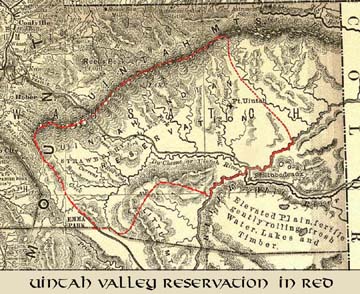
Hillers stereoscopic photo Elkskin Tepee, Utah
In his 1885 annual report, Agent Elisha M. Davis stated his observation of differences between the Uintah and White River bands of Utes. The two bands had shared the Uintah Reservation in Utah since 1882. Davis began his assignment about the time the White River Utes were relocated from Colorado. By the time of this report he had known both groups for three years.
The Uintahs branched off from the great Ute nation and settled by themselves in this valley many years ago. The Uintahs are an agricultural people, depending very little upon the chase [hunting]. The habits and customs of the Uintah Indians are more nearly like those of the tribes north of them. The language of the Uintahs is, I apprehend, the pure Ute language, it having undergone little or no change since they settled here.
The White Rivers have never taken kindly to agriculture. The chief cause of the Meeker massacre was because Mr. Meeker tried to compel them to work. They have never been contented to settle down in one place. Their habits are more like their southern neighbors. Their language is different in many respects from that of the Uintahs, it [the White River language] being strongly tinctured with Spanish.
Agent Davis held the U.S. Government responsible for some of the conflicts between the Uintah and White River Utes. Being forced to share their reservation land with the White Rivers was difficult enough for the Uintahs.
To widen the breach, between them, the Uintah were compelled to stand peacefully by and see the White River Utes, whose hands were reeking with the blood of Agent Meeker, his family and his employees, receive a large cash annuity, when they were brought here in 1882, and they [the Uintahs] receive nothing…and then a large herd of beef cattle belonging to the White River Utes was brought here at the same time, which was issued to them in abundance, while the Uintahs received little or none.
The Uintah Utes were included as part of the “Confederated Band of Utes” who shared an annual cash annuity of $50,000 for giving up reservation land. When divided among roughly 3,300 eligible Utes, each person’s share was about $15 per year. However, “pensions” to families of the Meeker victims, totaling about $3,000 per year, were paid out of the White River share of the annuity. This reduced the share received by each White River Ute to $13 per year.
From “Reports of Agents in Utah,” Annual Report of the Commissioner of Indian Affairs 1885
 In 1918, Congress authorized money for improvement projects on the Ute Reservation in Utah.
In 1918, Congress authorized money for improvement projects on the Ute Reservation in Utah.
 Indian Agent annual reports of reservation status, published in the Annual Report of the Commissioner of Indian Affairs, offer a glimpse into life after resettlement.
Indian Agent annual reports of reservation status, published in the Annual Report of the Commissioner of Indian Affairs, offer a glimpse into life after resettlement.


